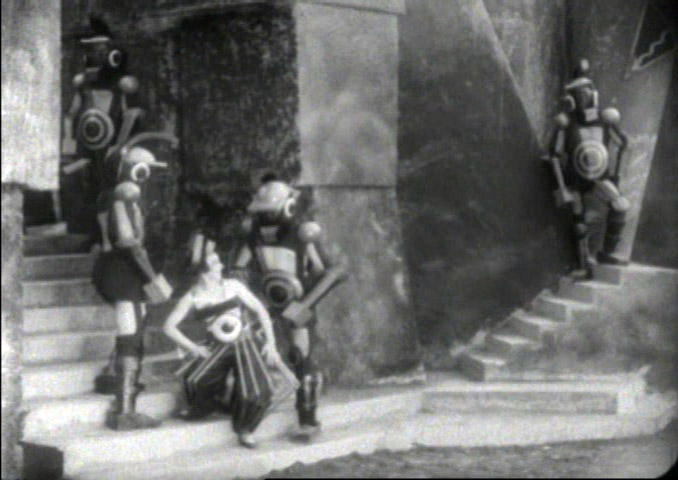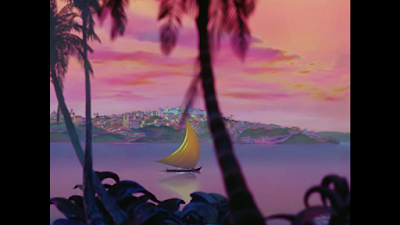ESTA CRÍTICA TEM SPOILERS / THIS REVIEW HAS SPOILERS
Marte! O sonho de muitos aventureiros, astronautas e
lunáticos. Um local que já foi visitado, através do cinema: eu já escrevi sobre
viagens cinematográficas para Marte antes, mas há uma lista infindável de
filmes com passagem por Marte. Um destes filmes, feito na União Soviética na
era muda, é o estranho filme de propaganda “Aelita – A Rainha de Marte”, de
1924.
Mars! The dream of many adventurers, astronauts and
lunatics. A place that was already visited, through cinema: I’ve talked about
movie trips to Mars before, but there is a never-ending list of films with a
passage to Mars. One of these films, made in the Soviet Union in the silent
era, is the strange propaganda flick “Aelita, Queen of Mars”, from 1924.
Em Marte, a rainha Aelita (Yuliya SoIntseva) vê
num telescópio os habitantes do planeta vizinho, a Terra, com genuína
curiosidade. Ela se apaixona por um dos terráqueos. Enquanto isso, na Terra,
muitas pessoas em laboratórios recebem uma estranha mensagem: “Anta Odeli Uta”.
Acreditando ser uma mensagem de Marte, o engenheiro Loss (Nikolai Tsereteli)
decide construir uma nave espacial para visitar o planeta vermelho.
On Mars, Queen Aelita (Yuliya SoIntseva) sees throw a telescope the inhabitants of the neighboring planet, Earth, with genuine curiosity. She falls in love with one of them. Meanwhile, on Earth, several people in laboratories receive a strange message: “Anta Odeli Uta”. Believing it’s a message from Mars, the engineer Loss (Nikolai Tsereteli) decides to build a spaceship to visit the red planet.
Depois de seis meses trabalhando numa usina, Loss volta para casa e encontra a esposa Natasha (Valentina Kuindhzi) numa pose comprometedora com um canalha. Loss atira em Natasha e decide que é hora de ir para Marte. No planeta vermelho, ele encontra Aelita e causa profundo impacto com mudanças para os menos afortunados.
After six months working on a power plant, Loss returns home to find his wife Natasha (Valentina Kuindhzi) in a compromising pose with a scoundrel. Loss shoots Natasha and decides it’s the ideal time to go to Mars. On the red planet, he meets Aelita and has a deep impact on changing how things happen there for the less powerful.
Marte em “Aelita” é futurístico, mas não muito. As roupas usadas pelos marcianos são brilhantes e curiosas – mais curiosas que belas. Não há equipamentos futurísticos mostrados além do estranho telescópio do começo do filme. É futurístico em Marte, mas a norma social vigente é construída em cima da escravidão.
Mars in “Aelita” is futuristic, but not so much. The clothes worn by the Martians are shiny and curious – more curious than charming. There is no futuristic gadget shown other than the weird-looking telescope from the beginning. It’s futuristic on Mars, but the societal norm is built on slavery.
Loss acredita que pode ajudar a “reconstruir a Rússida” com sua missão para Marte. A mensagem “Anta Odeli Uta” é recebida em quatro de dezembro de 1921: apenas quatro anos após a Revolução Russa. Neste sentido, “Aelita” é um tipo estranhíssimo de propaganda, pois os russos vão para Marte para ajudar a estabelecer uma União de Repúblicas Socialistas Soviéticas por lá.
Loss believes he can help “reconstruct Russia” with his mission to Mars. The message “Anta Odeli Uta” is received on December 4th, 1921: only four years after the Russian Revolution. In this sense, “Aelita” is the oddest kind of propaganda, as the Russians who go to Mars help establish a Union of Socialist Soviet Republics there.
Yuliya SoIntseva é mais lembrada hoje como a primeira mulher
a ganhar o prêmio de Melhor Direção no Festival de Cinema de Cannes, com o
filme “A Epopeia dos Anos de Fogo” (1961). Yuliya foi casada com o diretor
Aleksandr Dovzhenko e estreou como assistente de direção no seu filme “Terra”
(1930), hoje um clássico cult. “Aelita” foi o primeiro trabalho de Yuliya como
atriz, e ela apareceu em outros sete filmes até 1930, quando fez a mudança para
trás das câmeras. Yuliya dirigiu 14 filmes entre 1939 e 1980.
Yuliya SoIntseva is best remembered today as the first
female filmmaker to win the Best Director Award at the Cannes Film Festival,
with the film “The Story of the Flaming Years” (1961).
O director Yakov Protazanov estava voltando do
exílio. Ele havia deixado o país durante a Revolução Russa, e fez filmes na França
e na Alemanha enquanto estava exilado. Protazanov fazia filmes desde 1909, quando
dirigiu seu primeiro curta, e escreveu boa parte dos filmes que dirigiu.
Director Yakov Protazanov was coming back from exile.
He had fled the country during the Russian Revolution, and made films in France
and Germany while on exile.
Algo que ninguém esperava: o filme é baseado
num romance de Tolstoy. Mas não é Lev Tolstoy: o autor é Alexei Tolstoy, um
homem provavelmente assombrado por ter o mesmo nome de um autor conhecidíssimo.
Mais lembrado hoje exatamente por escrever o material que deu origem a “Aelita”,
Alexei Tolstoy é também o autor de “The Golden Key, or Buratino’s Adventure”,
algo que surgiu como um fanfic de Pinóquio.
Something nobody expected: the movie is based on a novel by Tolstoy. But it’s not Leo Tolstoy: the author is Alexei Tolstoy, a man probably plagued by having the same last name of a remarkable writer. Best remembered today exactly for writing the material that gave birth to “Aelita”, Alexei Tolstoy is also the writer of “The Golden Key, or Buratino’s Adventure”, something that was originally a Pinocchio fanfic.
Eu ouvi falar tanto de “Aelita” nos últimos anos e estava
animada por finalmente poder conferir o filme. Infelizmente, minhas
expectativas eram altas demais, e acabei a sessão frustrada. Eu esperava mais
cenas em Marte e, o pior de tudo, o filme tem meu tipo mais odiado de Deus ex
machina: a resolução “foi tudo um sonho” – neste caso, foi tudo um sonho
acordado. Eu reconheço a importância de “Aelita” para a história da ficção
científica e como o filme influenciou o retrato de Marte e dos marcianos em
filmes subsequentes. Há muito para se gostar em “Aelita” – isto é, se você não
estiver esperando um filme só sobre Marte. É possível fazer uma viagem melhor
para Marte em outros filmes.
I’ve heard about “Aelita” so much over the years and was excited to finally see it. Unfortunately, my high expectations weren’t met and I left the session underwhelmed. I expected more scenes in Mars, and, the worst of all, the movie had my least favorite kind of Deus ex machina: the “it was all a dream” resolution – in this case, it was all a daydream. I recognize the importance “Aelita” has in sci-fi history and in shaping the overall look of Mars and Martians in future films. There is plenty to like in “Aelita” – that is, if you don’t come expecting a huge Mars festival. You can take a better trip to Mars elsewhere..



























